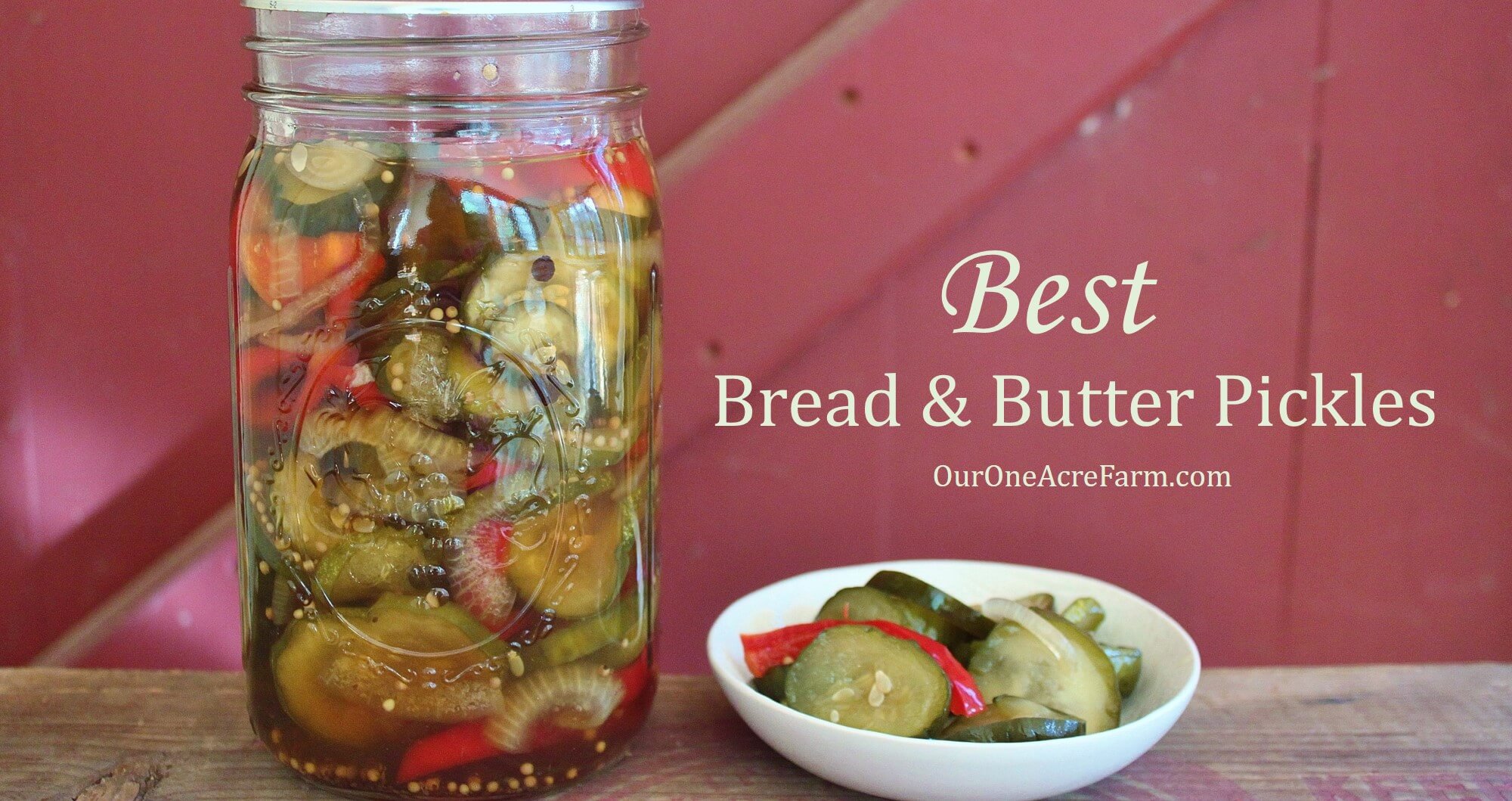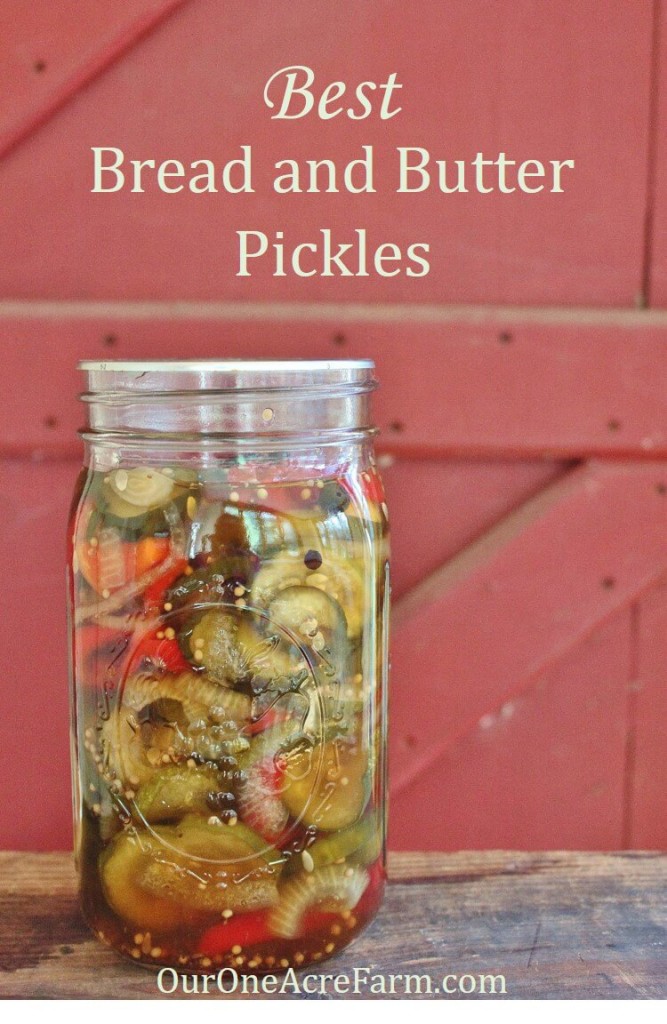
The combination of spices, the brown sugar, and the apple cider vinegar make these bread and butter pickles special.
It’s midsummer, and the vegetable garden is ripe with the bright colors of tomatoes, carrots, sunflowers, squash…and of course, cucumbers. I use the cukes in a variety of cold salads and soups, but my only way of preserving cucumbers is with this recipe for bread and butter pickles. They make an ordinary sandwich into something special.
I tried several recipes for bread and butter pickles before using the one that was the inspiration for this one. I didn’t like any of them. Finally, I turned to a classic: This recipe is an adaptation of Irma Rombauer’s Bread and Butter Pickles in the 1975 version of Joy of Cooking. I’ll be honest, I didn’t love it the first time I made it, but when I swapped the turmeric for allspice and increased the proportion of cucumbers (relative to the peppers and onions), I finally hit upon scrumptiousness.
After adjusting Rombauer’s recipe to something I loved, I entered the pickles in an agricultural fair, thinking I had a winner. I didn’t realize at the time that home canned goods were judged, at this particular fair, only on appearance. I also didn’t realize that bread and butter pickles (according to the judge at this fair, anyway) were supposed to be very green, with clear fluid. Mine were judged as poor, because the liquid was “too brown”.
But they were supposed to be brown! The ingredients that make the liquid brown are also those which make these pickles delicious: the apple cider vinegar and brown sugar. So, if you’re like that judge and want no browning in your bread and butter pickles, use white vinegar and white sugar. But if you want them to taste really, really good, use ACV and brown sugar.
About the Ingredients for Best Bread and Butter Pickles
The vegetables
I’ve used both the regular and pickling type cucumbers for this recipe. Either is fine. Bread and butter pickles don’t usually have bell peppers, but the splash of red makes them look nicer, in my humble opinion. They don’t really affect the flavor, so you can omit them if you prefer. Just be sure to add an extra couple of cucumbers so you’ll have enough vegetables for the volume of fluid.
The salt
Iodized salt is not recommended for pickles because the iodine can make the pickles “dark”. That is a no-no in the world of canning, apparently. But I’ll tell you a secret: I’ve used iodized salt in the past. The pickles were darker, but they tasted just fine. You can read more about the reasons for using pickling, Kosher, or pure sea salt here, and then decide what you want to use.
The sugar
If you’re looking for pure green bread and butter pickles with no darkening, you can substitute some or all of the brown sugar with white sugar. I have made this with all white sugar, but I think they taste better with brown sugar.
The vinegar
Here again, the choice of vinegar, apple cider vinegar, in this recipe, contributes to darkening of the liquid. You can use plain white vinegar if you want…but it tastes better with ACV.
The spices
I never liked bread and butter pickles until I found this recipe, and a big difference between it and other recipes is the blend of spices. The whole spices look nice floating around with the vegetables, but you have to remove the cloves and allspice berries when you eat the pickles, which can be annoying. If you don’t want them floating around in yours, just put the cloves and allspice berries in a spice bag as mentioned in the recipe below, and remove the bag before pouring the pickles into the jars.
Water Bath Canning
Water bath canning is used to preserve these pickles. If you are new to this process, I strongly recommend you read this tutorial before starting. The necessary supplies and the entire process are described and illustrated in great detail.
Best Bread and Butter Pickles Recipe
Yields about 5-6 quarts
- 6 quarts thinly sliced cucumbers (slice them before measuring)
- 3 medium yellow onions, sliced thinly, or chopped
- 2 red bell peppers, stem, seeds and membranes removed, and sliced
- 3/4 cups pickling salt, Kosher salt, or pure sea salt
- 6 cups apple cider vinegar
- 6 cups brown sugar
- 2 and 1/2 tsp whole allspice berries
- 2 and 1/2 tsp mustard seed
- 2 tsp celery seed
- 1 and 1/2 tsp whole cloves
- In a large bowl, mix the vegetables with the salt and refrigerate 8 hours or overnight.
- Wash the canning jars and lids. Sterilize the jars in a large pot by boiling in water for 10 minutes. Current recommendations say that lids should not be sterilized, because the lid can distort, resulting in failure to seal. But I’ve never had this happen, so I still boil my lids in a small pot for 10 minutes. Turn heat off after 10 minutes and leave jars in their pots of hot water, covered, until ready to use. Decide for yourself whether to sterilize the lids or not.
- Drain the vegetables, rinse with cold water, drain again, put in a large pot, and set aside.
- Put the vinegar, sugar, and spices (you may put allspice berries and whole cloves in a cloth spice bag if you do not want them in the finished pickles) in another large pot, bring to a boil, and remove from heat immediately.
- Slowly pour the hot syrup onto the vegetables, and stir gently.
- Heat to 185 degrees F, then remove from heat. If you used a spice bag, remove it now.
- Remove jars from the pot, and discard the water inside each jar.
- Pour into sterilized canning jars, using a canning funnel, leaving 1/2 inch head space.
- With a clean towel moistened with hot water, wipe the rim of each jar clean.
- Using clean tongs to pick up the lids, place a lid on each jar. Screw on the bands until tight.
- Make sure the water level is about 2 inches above the tops of the jars, and bring to a boil.
- Boil for 10 minutes if using pint sized jars, or 15 minutes if quart sized.
- Remove jars from boiling water bath, and allow to cool at room temperature. As the jars cool, the volume within the jar will contract, pulling the lids inward, if the jar is properly sealed. When that happens, you will hear a little snap.
- After several hours, check for proper seal by gently pressing down on each lid. It should be firm. If it flexes up and down, it did not seal. Any jars that did not seal need to be refrigerated and used within a week or so. Properly sealed jars can be stored on the shelf in a cool, dark location, such as a basement.
Sources:
Rombauer, I. S. 1975. Joy of Cooking. Bobbs-Merrill Company, New York, NY.

Please pin THIS image.











I have been canning most of my life and would love to try this recipe. I am unable to copy it. I like to save the stories of where my recipes came from. Could you please send this page to my E-mail…Thanks…Jennie Barney
Hi Jennie, I am honored that you’d like to try it! There is a print icon at the top left of the page, next to the facebook share button. Try that, and if it doesn’t work, let me know and I’ll send the recipe to you via email. I had to disable copy/paste, because some of my posts were getting stolen and republished by other bloggers.
Yes the print icon works then it prints 6 pages and the recipe is on 2 of the six pages. Can you make your page work a little better? Thanks.
I sent it via email, David.
I also could not print would you be so kind to email the recipe. Thank you.
I just emailed it to you, Nancee.
My MIL usually sends us jars of bread and butter pickles every year. This year, I’m going to send her some.;) These look great, thanks for the recipe, I’ll be trying it out soon!
That’s great, Adriana, I hope you do try them, and let me know if you have any suggestions. Thanks for stopping by!
Just to let you all know, I have installed a new print button which should allow you to delete whatever text you don’t want to print.
My pickles turned out mushy!
You mean using this recipe?
I just found your web page tonight while looking for making maple syrup. I know I will have a ton of fun checking out all the cool stuff you do. I have subscribed to your newsletter, too. (smile)
Welcome, Deb. I am glad you are finding it useful!
Could you please send the Bread and Butter Pickle recipe to my email?
Thank you..
Patti
Hi Patti, no, I can’t send it in an email, but you can print it out or download as a pdf using the print button just above the lead photo.
I can’t wait to try this recipe Did you put the berries and cloves in a sack or just put them in your pickles
I just put them in the pickles but you can put them in a sack if you want to be able to remove them.
Pingback: Bread & Butter Pickles | Last virals
Oh wow, those look really good! I love bread and butter pickles, and as long as they taste good, I don’t care what color they are, haha. I’ll definitely try your recipe, thank you for sharing it!
Pingback: Bread and Butter Pickles – Homesteadrr